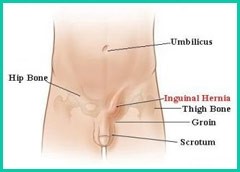Inguinal hernias are the most common types of male hernias, that are located in the lower abdomen and thigh going towards the scrotum, as a bulge in the groin. They are more common in men than women. Inguinal hernias usually occur when fatty tissue or part of a bowel, bulge out through a part of the lower abdominal wall known as inguinal canal.

There are two types of inguinal hernias:
1. Direct inguinal hernia Occur as a result of weakness in the floor of the inguinal canal. They are usually bilateral and seen in elderly with chronic conditions which increase intra abdominal pressure such as chronic cough, chronic constipation etc.
2. Indirect inguinal hernia occur when the inguinal canal fails to close before birth. The hernia may appear in a male’s scrotum or in the fold of skin at the opening of a female’s vagina. This is the most common type of inguinal hernia. And it may occur at birth or later in life. Indirect hernias are more common in males.
However, it uses standard weight status categories that can help doctors to track weight status across populations and identify potential issues in individuals.